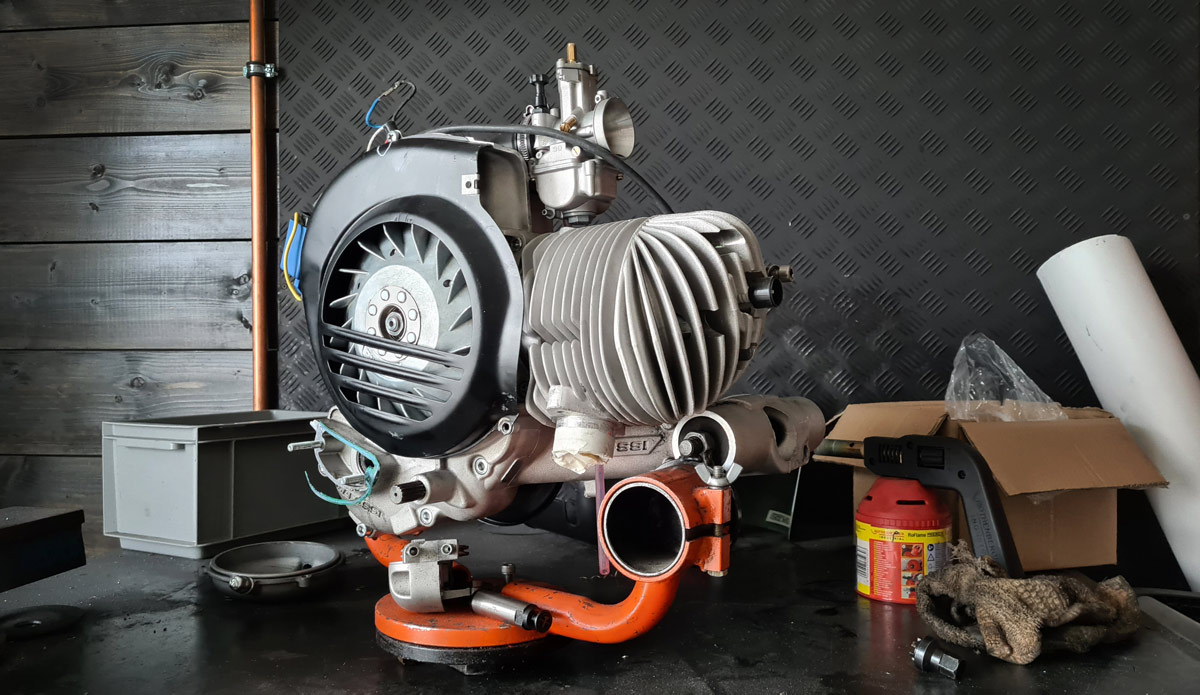Part 5 for Stage 4
As with so many things in life, fortunately, everyone has their preferences... More RPM and more peak power or more torque at lower RPM. That’s why in today’s part, I’m once again looking for more… but not peak power, but instead more power band and torque. The "tractor engine" is what we're searching for.
In
Part 4 with Stage 3, I had already started exploring higher valve angles by raising the cylinder and making some modifications to the exhaust. If I were to raise the exhaust further now to perhaps reach higher peak power and RPM, the way back; trying the cylinder with more advance at lower valve angles would be blocked. So today, I set the cylinder lower. As a result, the valve angles are slightly reduced, but the advance increases slightly. The smaller transfer angle should allow the cylinder to produce more torque at lower RPM. The spacer at the cylinder head changes from 1mm to 3mm compared to Stage 3. At the cylinder base, the 2mm spacer leaves the field and the cylinder is now only mounted with a standard 0.3mm thick gasket. The squish clearance remains the same as in the other stages at 1.3mm. In the following graphs, the current curves of Stage 4 are shown in
RED. The curves from the previous Stage 3 appear in
BLUE.

First up is Elron, showing what it thinks of the changes.

As expected, the absolute peak power drops slightly, but the power and torque maximums shift towards lower RPM. Torque increases slightly and feeds the range between 5100 and 7000 RPM. The Polini Box, which is typically aimed at engines with less transfer time, takes its place on the exhaust manifold next.

At first glance, the curves may seem disappointing. However, upon closer inspection, the Polini Box turns out to be a true torque monster. At the end of this test series, it ranks second in the torque range with 37.4 Nm. The graph already passes the 20 hp mark at 4700 RPM. The power maximum shifts a substantial 1000 RPM towards lower RPM, peaking at 6400 RPM. The maximum torque pulls at 6000 RPM at the rear wheel. This engine setup practically begs for a long gearbox. It can move the M244 lazily over the asphalt. From the stand, shift into gear 4 and just pull on the cable. Don't worry, it'll get going fast... The aged all-rounder in the field.

The JL left-hand exhaust places its torque in the 5000 to 7000 RPM range, providing more rideability. The peak power drops by one horsepower, but the JL still offers very good rideability in the resonant exhaust range.
New Line

The hand-made exhaust from the north also responds as expected to the changes. At 5000 RPM, 20 horsepower are ready to pull hard. Full torque kicks in at 6100 RPM. While it does push the absolute peak power slightly down, the Newline gives up 2 horsepower in favor of earlier torque onset but takes the larger advance happily, allowing it to go over 10,000 RPM while maintaining over 20 horsepower. The Newline behaves almost like a box exhaust system, with a noticeable torque kick.
Posch Nessi

The sea monster pulls its head back a bit due to the reduced valve angles. But that’s not bad at all. Like with the Newline, the power band shifts slightly towards lower RPM and develops more torque. At 5200 RPM, the curve already crosses the 20 hp mark. The slightly increased advance helps the Nessi reach another power band.
Posch Racing Resi

The generous Resi processes the less suitable valve angles surprisingly well. While it loses peak power, it gives a hint of what might be possible with more advance and the right valve angles. With a power band of nearly 4100 RPM, it plays in the upper league.
Lakers

The Lakers, designed for significantly more performance, doesn’t like the flat valve angles. The exhaust craves larger time sections. The power band does shift towards lower RPM as expected, but the small time sections are not the right playground for the Lakers. But his chance will come with the next stages… Here’s a summary of the maximum values.











